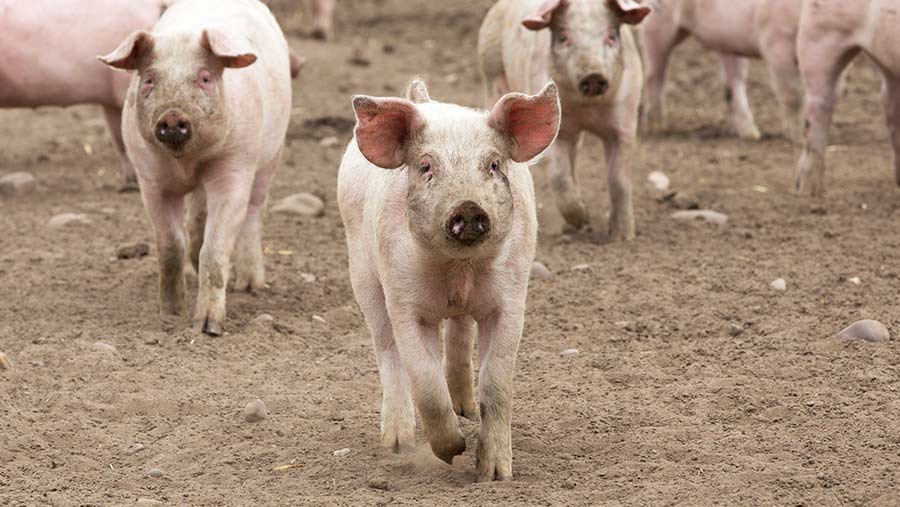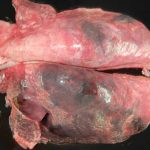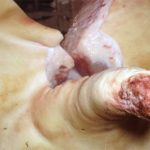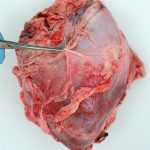New pig health scheme highlights disease early
 © Tim Scrivener
© Tim Scrivener The relaunched Pig Health Scheme, which starts this month, alerts producers to diseases they may not be fully aware of, and that negatively affect herd performance.
It is hard to determine disease prevalence where there are few visible signs of disease, or where the signs not necessarily considered problematic, but these can cause producers to lose money, for example by reducing growth rates.
AHDB’s Pig Health Scheme provides regular post-mortem reports highlighting disease issues early, so that producers can take action.
Pigs are examined at the abattoir by trained veterinary assessors, who look for 12 different conditions in the lungs, heart, liver, tail and skin (see ‘12 conditions monitored’ box below).
A report is sent to producers within two days, for discussion with their vet.
See also: How supplementary milk can improve piglet and sow production
AHDB pork processing projects manager Lauren Turner said: “Regular, active health planning with your vet is the most cost-effective way to reduce disease and improve welfare.
The Pig Health Scheme information provides vital evidence to add to your discussions and decision making.
“The data can also be used to monitor the effects of any changes, for example, to feed or vaccination programmes. A more complete picture of what’s happening in your herd will be achieved by looking at your data alongside antibiotic use patterns recorded on eMB, as well as physical performance figures.”
Health conditions monitored
Enzootic pneumonia (EP)
EP is detected in the abattoir as dark purple/grey and rubbery consolidated areas in the lungs.
Affected pigs have a mild, and often long-standing, cough which may go largely unnoticed. However, these animals will have reduced and variable growth and are more prone to other infections.
Pleuritis
Also known as pleurisy, pleuritis is painful. Pleuritis is inflammation of the lung surface with affected areas sticking to the chest wall, causing pain to the pig on each breath.
At processing, affected lungs need to be manually removed from the chest which slows the line and adds labour requirements in the abattoir and therefore additional costs.
In a recent study, when EP-like lesions and pleuritis were seen together, they resulted in each affected pig having a 2.52kg reduction in slaughter weight.
Tails
Damaged tails are a welfare issue and are associated with lower carcass weights. In severe cases, infection may spread throughout the carcass leading to condemnation of the whole carcass.
Trends should be monitored and increased incidence tackled promptly. Producers can use the WebHAT, AHDB’s online tool, to help reduce the risks of tail biting.
How to join
Pig producers can join the Pig Health Scheme through their Pig Hub account, using the same log-in details as for the electronic movement (eAML2) system, at www.pighub.org.uk
Members of the previous health scheme (BPHS) have been automatically enrolled to the relaunched Pig Health Scheme.
A list of assessment dates for each of the 11 participating abattoirs is available online at: ahdb.org.uk/news/pig-health-scheme-assessment-dates-announced
All pigs will be automatically assessed if they go to a participating abattoir on the assessment day and Pig Health Scheme members will receive reports within two working days of the assessment.
Reading reports
Pig Health Scheme members receive three different report sheets:
- Individual batch report, sent to producers within two working days
- Unit comparison report, comparing your units and all other units monitored during the latest quarterly monitoring period, sent at the end of the quarter.
- Time comparison report, comparing historical data for the unit on a rolling basis of up to two years (once data are available).
A Pig Health Scheme guide is available to help producers get the most out of the data in their report and spot if there is cause for concern.
In summary, producers should consider their unit’s reports alongside other data such as production data and information on the health status of the batch. This should be done in conjunction with their vet.
AHDB is keen to hear how producers have used their reports and if they have any suggestions for improving them. Contact Lauren Turner: lauren.turner@ahdb.org.uk or 02476 478977.
12 conditions monitored
The Pig Health Scheme assessor checks for prevalence and the levels of the following conditions in the carcass:
Lungs
- Enzootic pneumonia-like lesions
- Viral-like lesions
- Pleuropneumonia
- Pyaemia
- Pleuritis
- Abscesses
Heart
- Pericarditis
Liver
- Milk spot
- Hepatic scarring
- Peritonitis
Tail
- Damaged tails
Skin
- Papular dermatitis
- Acute pleuropneumonia
- Tail bite
- Pericarditis
Case study: Knowledge we don’t get anywhere else
Lincolnshire pig producer Meryl Ward is looking forward to receiving health reports again – she was a member of the original scheme.
“It will give us detailed post-mortem health information from our slaughter pigs that would not be available without producers paying for their own veterinary advisors to go into the abattoir.
“This collaborative industry project is a much more cost-effective means of acquiring valuable trend data on key health indicators.
“The health scheme report was a standard item for discussion with our vet at our quarterly meetings and we’ll be doing that again now.
“Hopefully disease is rare and those discussions are short. However, if the report shows us something has changed, it’s usually the first flag that something’s not quite right and prompts us to look into it further before it becomes a bigger problem.
“The lung scores have been particularly useful. We were EP- and PRRS-positive, and the reports helped us decide changes to vaccination programmes.
“For example, we switched from a one-shot to a two-shot EP vaccination, which better suited our circumstances and was more effective.
“From a national point of view, the information on disease trends throughout the industry is invaluable. Pig producers should just get signed up to the relaunched scheme.”




